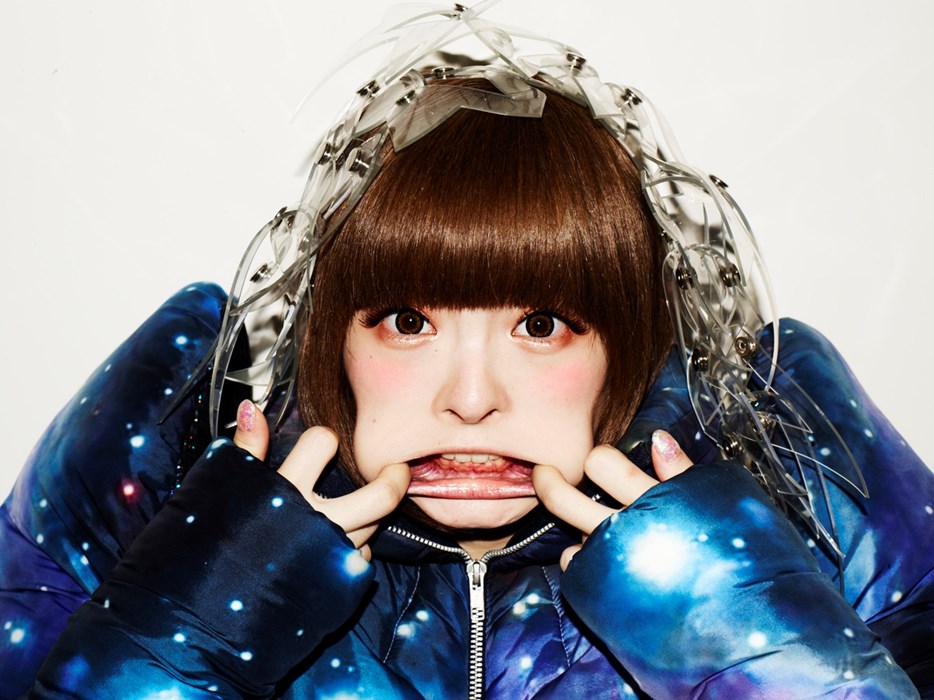Memo #402
By: Atsumi Nakao – atsumi.o.1106 [at] gmail.com

The word “kawaii” triggers associations with Japanese manga and anime characters. One specific variety of “kawaii” is “Harajuku-style” or “Harajuku-kawaii”. An excessively colorful and decorative subculture of fashion, goods, and community, it emerged from the streets of Harajuku, a neighborhood in Tokyo, and flourished as young schoolgirls’ subculture throughout the 1990s.
The current symbol of Harajuku kawaii is Kyary-Pamyu-Pamyu, a singer and model who is famous in Japan and growing in prominence both in and outside the country via the Internet and her contract with Sire Records signed in 2013. Her music videos are significant in that they embody the fraught and contradictory nature of “kawaii”: both a constricting trap that renders “kawaii” a decorative puppet for the global market and at the same time an empowering form of bricolage that challenges dominant norms.
Her transfixing music videos are colorful, vivid and loud, but the faceless creatures and her deformed body that also make regular appearances in them depict uncanny otherness. Kawaii contains within it a monstrous cuteness that flames its desirability and consummability as the different Other, not just as exaggeration but as subversion. Kyary-Pamyu-Pamyu’s music videos Ninjari-Bang-Bang and Furisodation project the hybridity of traditional and stereotypical Japanese themes such as Ninja and Kimono, and at the same time elements of cutting-edge kawaii-ness. These works of deliberately exaggerated self-Orientalization direct the “Western” gaze towards an exotified Japan. In this sense, kawaii and its embodiments are trapped by the neo-liberal directive of othering the self to generate competitiveness in the global market.
On the other hand, Kyary-Pamyu-Pamyu challenges conservative ideals of appropriate feminine appearance, and offers alternative values to a number of young people around the world. Harajuku kawaii has become re-invigorated as a result of this empowering and subversive element. Somewhat ironically, due to her rising global popularity, the Japanese government’s Agency for Cultural Affairs appointed Kyary-Pamyu-Pamyu as an ambassador to promote cultural assets on the Japan Heritage list in 2016.
Thus, kawaii is not just a synonym for cute, nor something that can be reduced to one dismissive generalization. The complex entanglements underlying the seemingly unthinking invocations of kawaii, whether by Kyary-Pamyu-Pamyu or others, require nuanced readings.
About the Author:
Atsumi Nakao is a PhD student in the department of Asian Studies at the University of British Columbia. Her research focuses on visual media and gender discourses in contemporary Japan.

Kyary-Pamyu-Pamyu (Credit: Dazed)

Girls dressed up in Harajuku style for Vancouver’s first Harajuku Fashion walk (Credit: Vancouver Sun)
Links
- Atsumi Nakao. “The formation and commodification of Harajuku’s image in Japan” Ritsumeikan Journal of Asia Pacific Studies 34 (2016): 10-19.
- Makiko Iseri, “Flexible Femininities? Queering Kawaii in Japanese Girls’ Culture,” in Twenty-first Century Feminism, eds. Claire Nally et al. (Basingstoke: Palgrave Macmillan, 2015), 140-163.
- Maja Brzozowska-Brywczyńska. “Monstrous/Cute. Notes on the Ambivalent Nature of Cuteness,” in Monsters and the Monstrous: Myths and Metaphors of Enduring Evil, eds. Paul L.Yoder et al. (NH : Rodopi, 2007), 213-28.
- Connie Wang, “What girls in Harajuku look like today,” Refinery 29, October 17, 2014.
- Ultra Nerdy, “Vancouver’s First Harajuku Fashion Walk (with video),” Vancouver Sun, February 8, 2016.
Related Memos:
See our other memos on Japan.